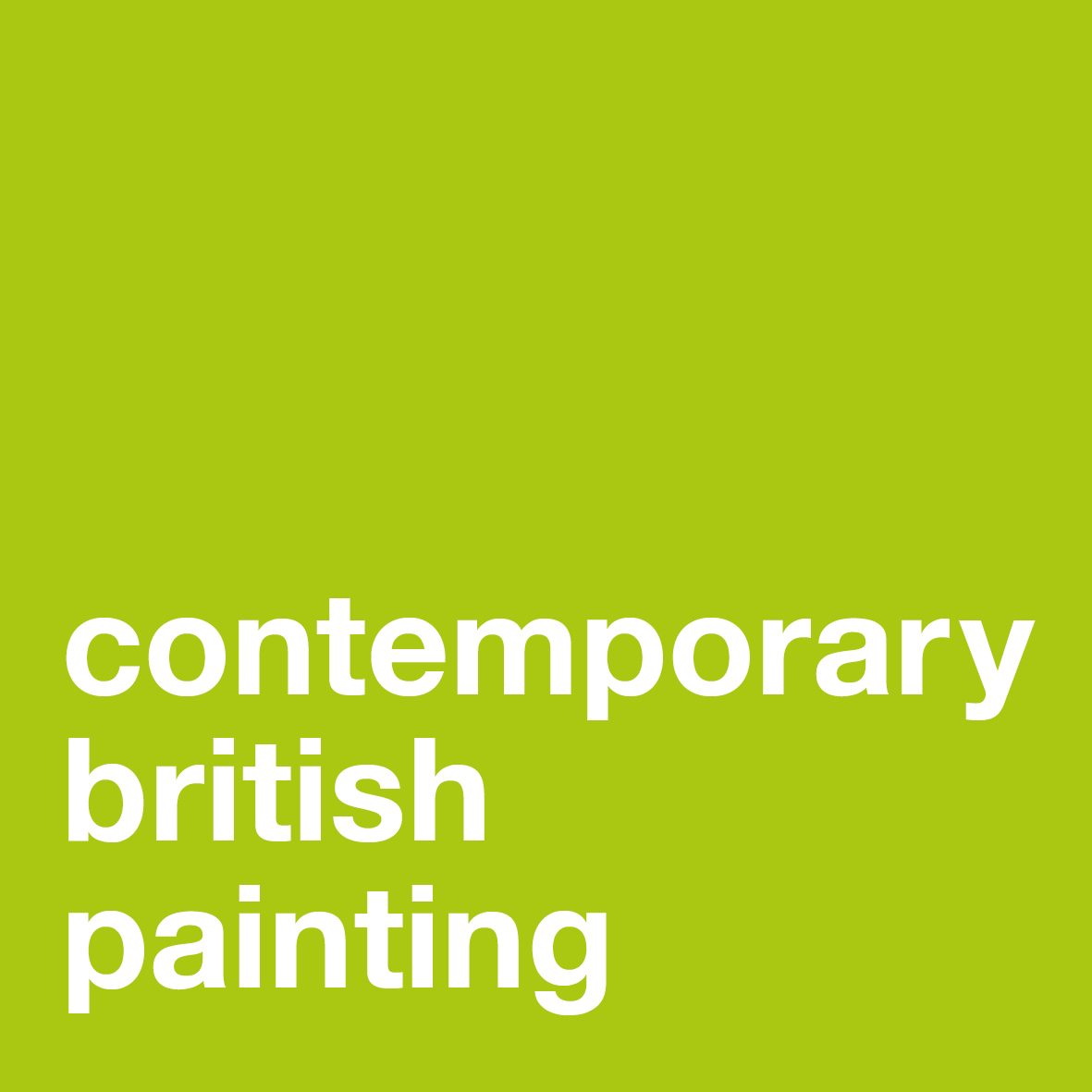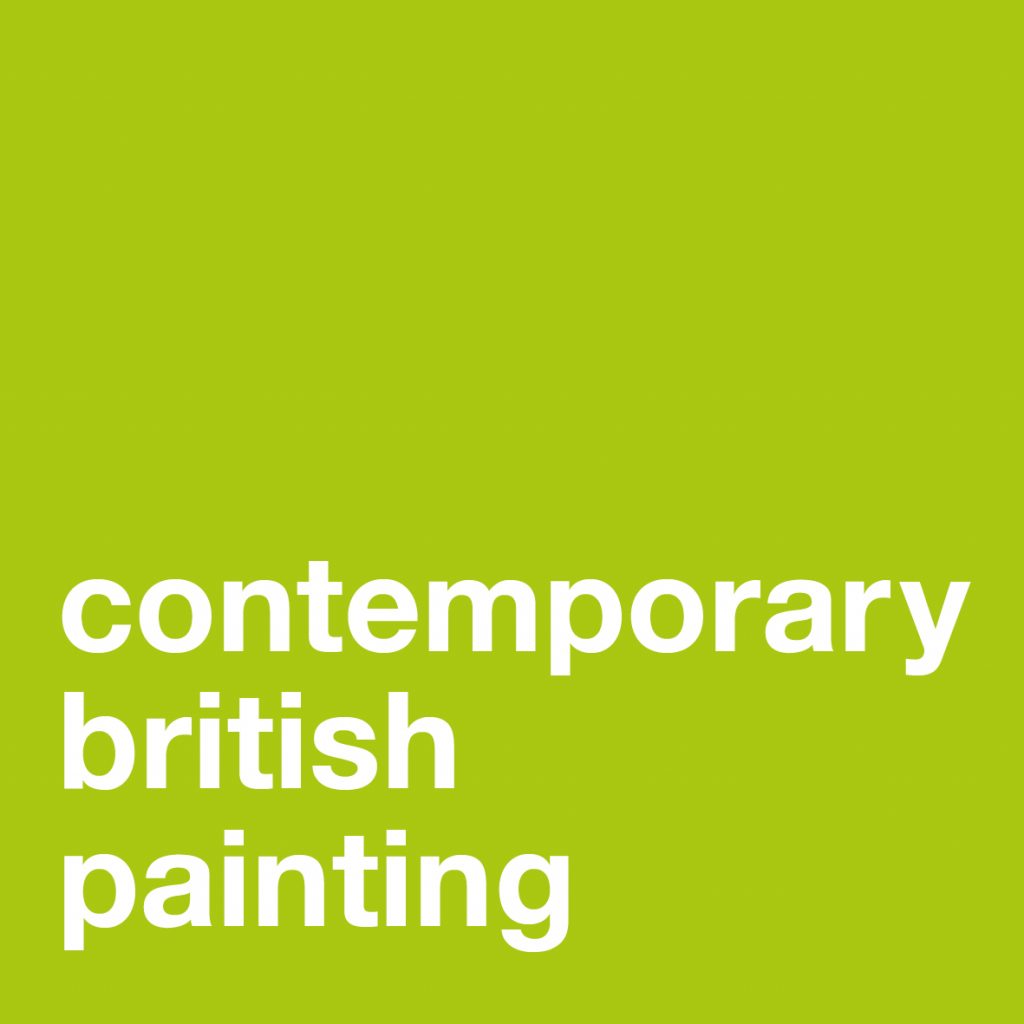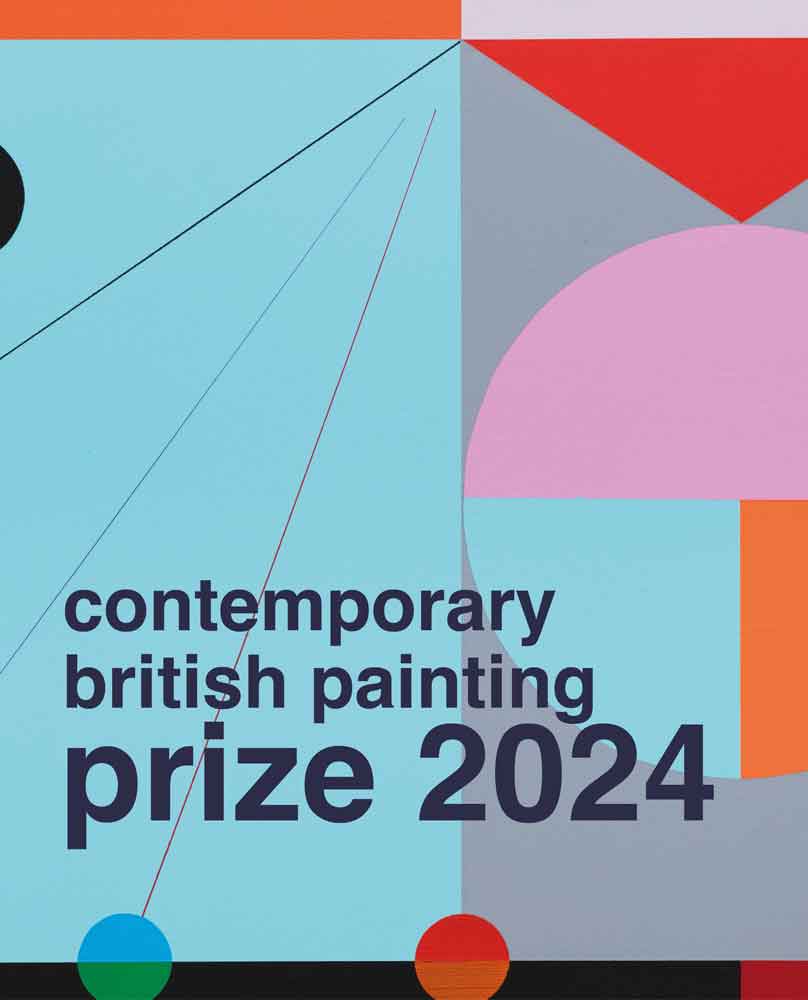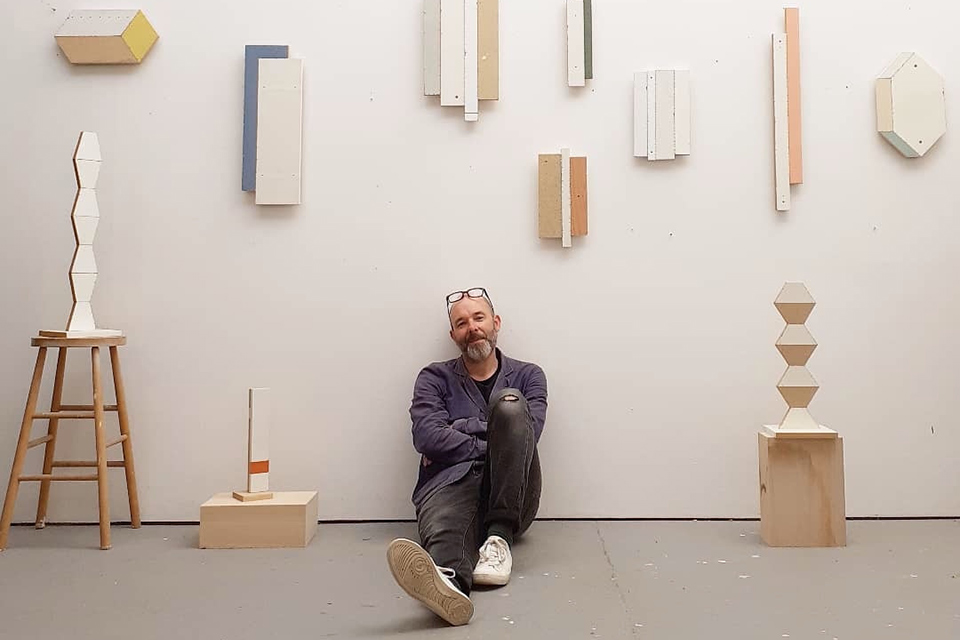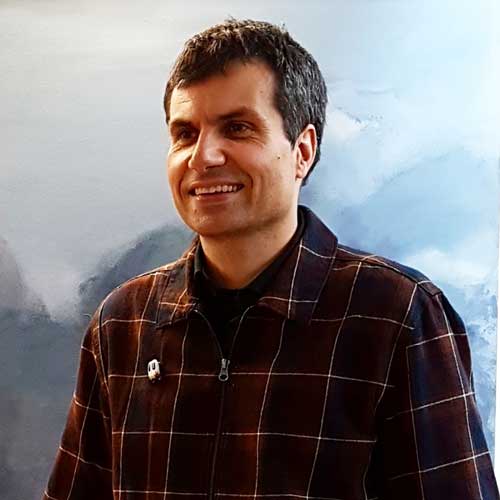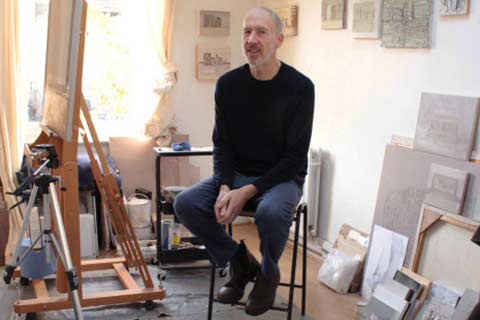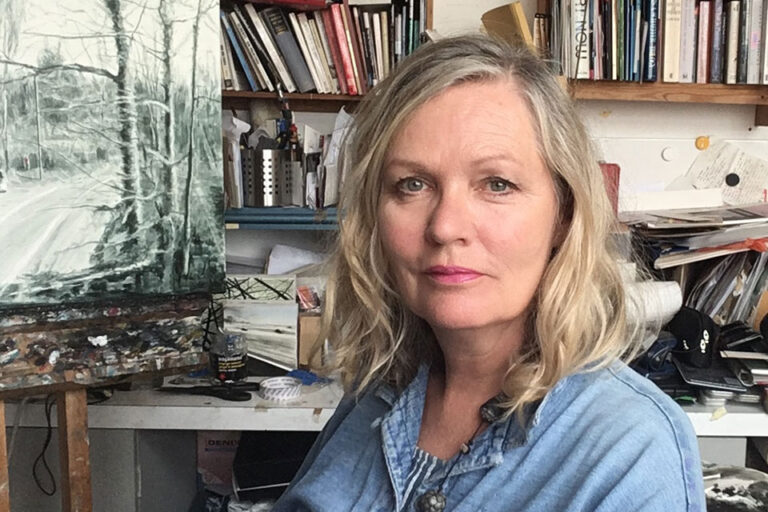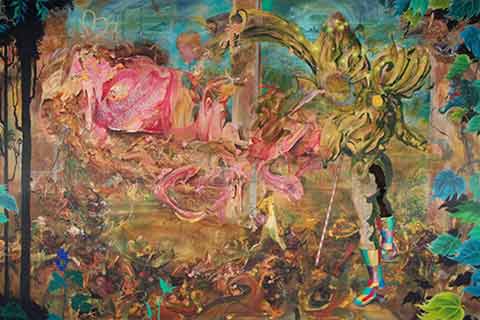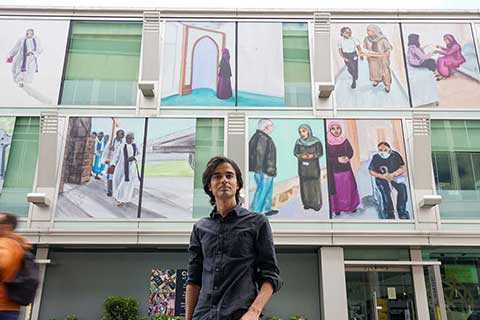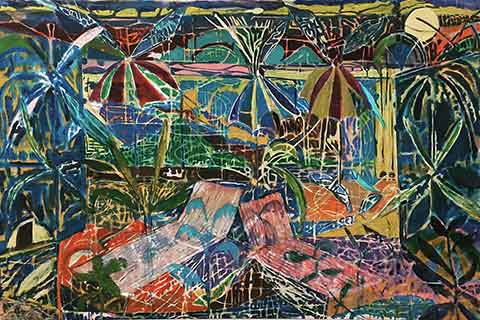Roland Hicks: Artist of the Month
Artist of the Month February 2025:
Roland Hicks, selected and interviewed by Paul Newman for CBP.
Roland Hicks makes paradoxical paintings and objects that look like minimal abstract assemblages – apparently slightly crudely stapled together from offcuts of various types of chipboard. Sometimes these pieces also create a simple illusion of a three dimensional geometric solid, or of one form sitting in front of a shadow form behind it. Less simply, all the joins, staples, different chipboard textures, roughly sawn edges etc are actually meticulously painted by hand – so, in addition to its abstract properties, his work is equally concerned with ‘trompe l’oeil’ still life painting…
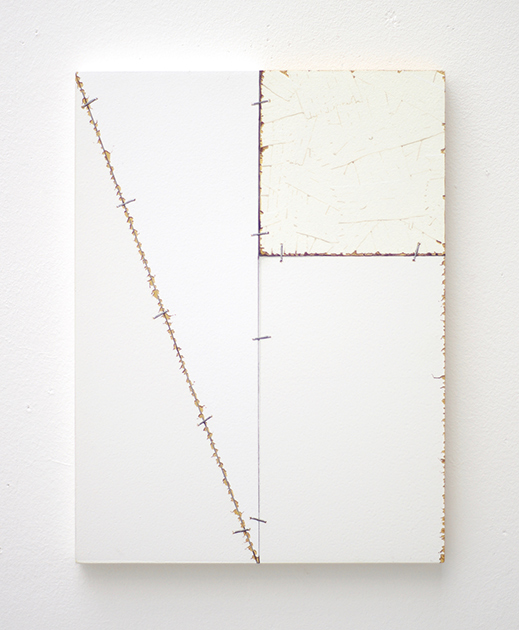
CBP: You create meticulous ‘trompe l’oeil’ painting installations based on ad hoc assemblages of painted off cuts of wood roughly stapled together. How long have you been painting this series and how did it evolve from your earlier painting career?
RH: I think the staples first appeared in 2018, but I’d been making ‘trompe l’oeil’ pieces based on different types of chipboard for a good while before that. Going back a few years further I’d been making photorealist still life oil paintings of discarded everyday objects and ephemera, which look very different to the current work – the newer work is much more abstract in appearance, but essentially I’m still making hyperrealist still life paintings of ordinary materials, it’s just that now those materials appear to exist in the same physical space as the person viewing them, rather then somewhere through the picture plane.
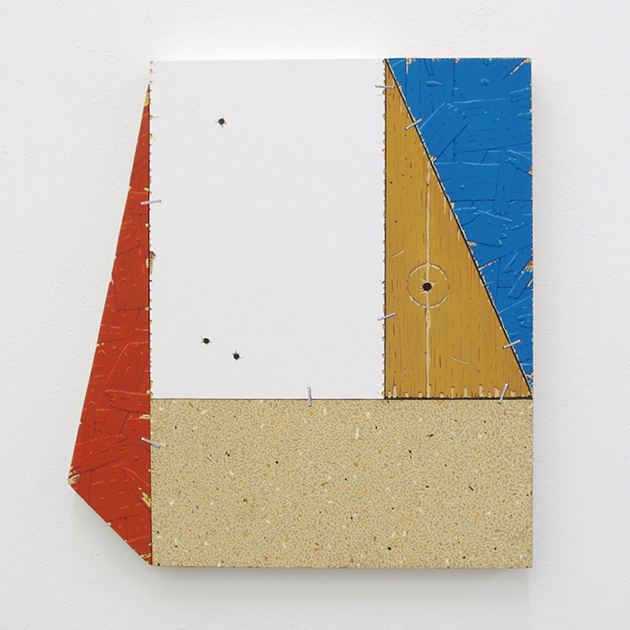
CBP: There is an open ‘deception’ with the meticulous facsimile of your paintings, as a form of mimetic art. The more veiled and complex one, according to your statement, are that the paintings are not based on actual models but invented. Can you discuss this aspect further and the slippage between the copy and the imagined?
RH: Yes, I like the fact that these are painted simulations of fictional abstract artworks. How do you copy something which never existed? There’s an impossible logic to this which appeals to me – I think this keeps the work in a kind of restless limbo where it is neither one thing nor another, or else two things simultaneously.
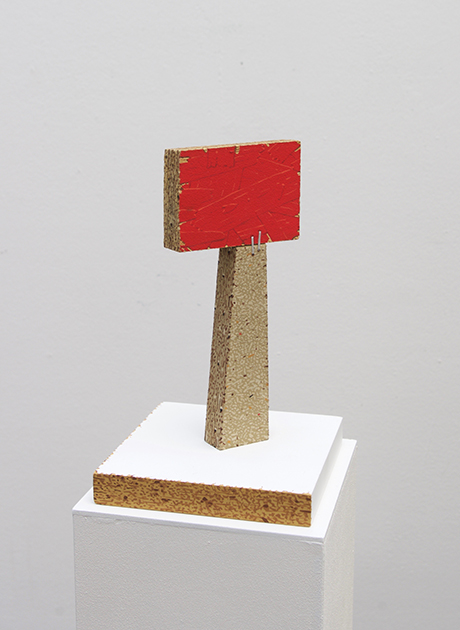
CBP: Your paintings play with two opposites within the scope of painting; painting as illustration, and painting as object / sculpture. Can you talk about how you explore and reconcile these notions?
RH: There are all sorts of other opposites at play too – obviously abstraction and realism, but also spontaneity and meticulousness, sincerity and deception, value and worthlessness, playful/serious and so on.
I’m not even sure if these are reconcilable notions, but perhaps that’s part of the appeal, embracing paradox, uncertainty and in-betweenness. I’ve always liked that Voltaire quote ‘Doubt is not a pleasant condition, but certainty is an absurd one’. Either way I seem to prefer questions to answers, but always within some kind of ordered framework. Rigorous ambiguity.
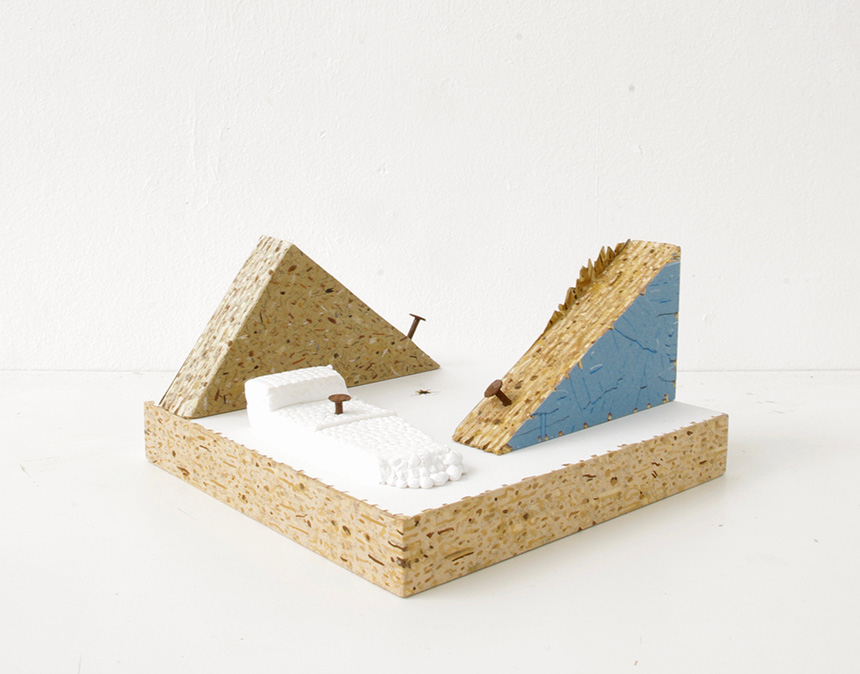
CBP: Your most recent work arranges painted objects on painted shelf and one example that pushes the hybridity of painting, sculpture and installation even further, can you discuss this in the development of your practice?
RH: The piece you refer to ‘Some Two-Bit Sculptures On A Two-Bit Shelf’ was originally a series of small, separate painted sculptures [which had previously been exhibited on a standard wall shelf]. I had some leftover pieces of painted mdf ‘wood’ from another project and just decided to turn these into a bespoke support to wall mount the sculptures, at which point it just came together as a single artwork. But I really enjoy the apparently primitive construction of the shelf – it looks like someone has just banged two bits of old wood to the wall in a hurry, but it also changes the sculptures, which suddenly seem more sophisticated than the thing they sit on. Perhaps it also further questions where the ‘art’ begins and ends.
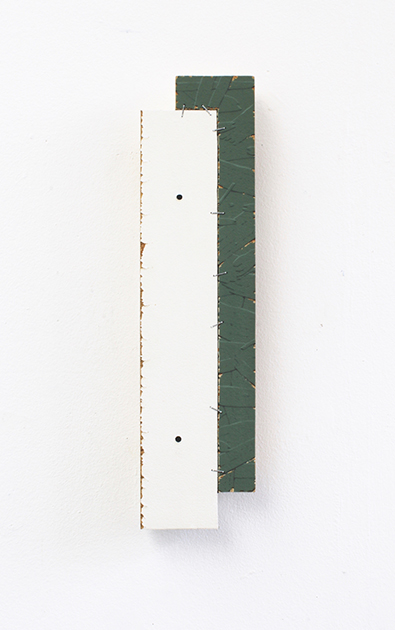
CBP: You constructed an ambitious installation ‘The 4th Wall’ at Hastings Contemporary in March 2024, which presented interpretations of doors and sealed openings. Can you talk about this project and the relationship between the ad hoc and the meticulous, the real object and the façade.
RH: The exhibition came about as a result of winning The Evelyn Williams Drawing Award in 2021. I worked directly on two of the gallery’s sea facing walls, using a combination of painting, drawing and collage to create the illusion that the walls were entirely constructed from a shoddily assembled patchwork of old doors, shelves, sections of cupboards or discarded flat pack-furniture – as if someone had raided skips, house clearance or fly-tip sites to quickly erect an inadequate barrier or line of defence. This offered up several metaphorical, political and narrative connotations, though it was typically quite open and ambiguous as to what the intention was, what was real or not, and also what was ‘art’ or not. I wanted to make something quite immersive, a bit like one of Kurt Schwitters’ merzbau works. It might be the closest I’ll ever get to making a Gesamtkunstwerk. It was also the first time I’d allowed myself to include some real objects alongside simulated ones – so there were a few real door handles, shelf brackets and so on, though confusingly some of these were also painted on to make them appear aged or rusty. Since that exhibition, I’ve continued to make work that might contain some of these non-simulated elements, I’m enjoying adding further layers of doubt into the work.
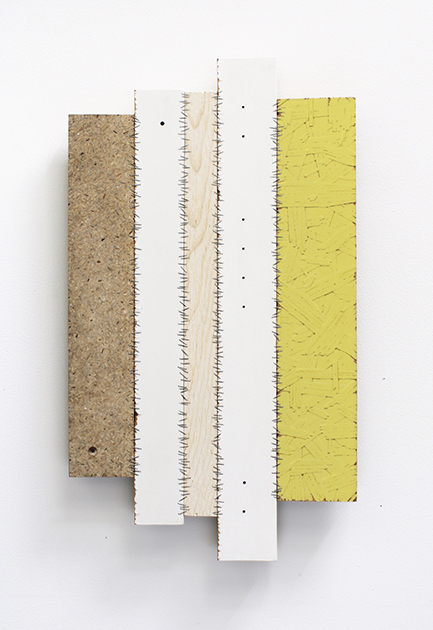
Quad-Zip Boogie, acrylic and acrylic gouache on shaped MDF, 61cm x 35cm x 3cm, 2022 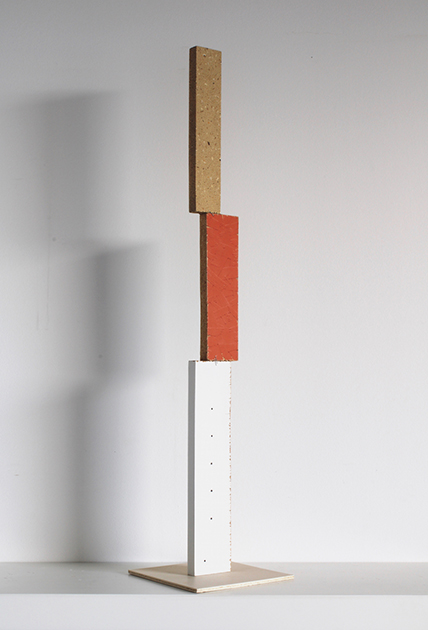
Heavy Levity, acrylic and acrylic gouache on shaped MDF, 78cm x 17cm x 17cm, 2022
CBP: Your paintings play a conceptual game with notion of what we are looking at in terms of painting, image and object that for me links to Magritte’s ‘C’est ne pas un pipe’ and his subsequent paintings of objects with misaligned words. Can you identify with this as a discussion point in your work?
RH: Magritte is a strange one – I think he’s one of those artists who appealed to me a great deal at a young age, but then dismissed as a bit of a cliché as soon as I got to art college. But some of it still stands up – though possibly more conceptually than as paintings for me. I think it’s probably fair to say there’s an element of surrealism in my own work, though it’s not my primary interest. Having said that, I did actually make a painted trompe l’oeil sculpture of a rusty length of metal pipe a few years back. Which was also not a pipe. And I do enjoy misaligned words and objects, double meanings and other kinds of language mangling – something I often bear in mind when it comes to titling work. Sometimes the titles are composite words, like their own form of collage.
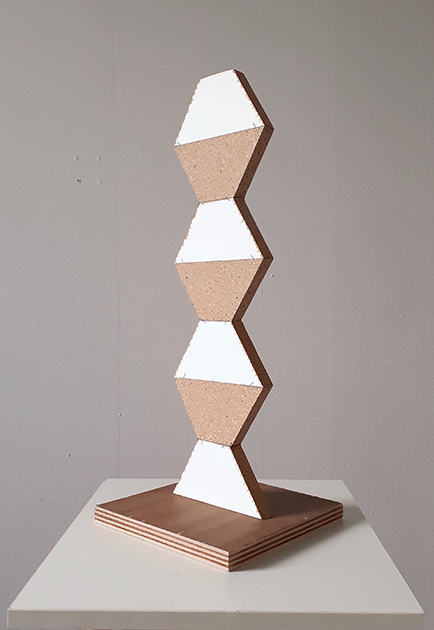
Brancusish, acrylic, acrylic gouache and chalk pastel on shaped MDF, 51cm x 20cm x 20cm, 2021-24 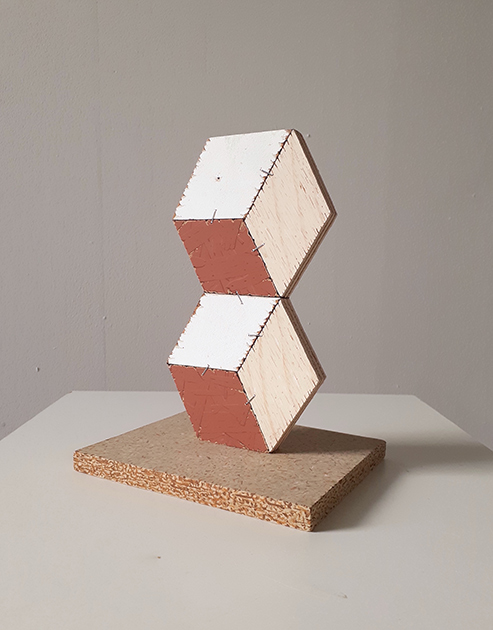
Things Pile Up, acrylic and acrylic gouache on shaped MDF, 20cm x 15cm x 12cm, 2022
CBP: Stripping away your conceptual and perception game playing, there feels a love of Modernist geometric abstraction both in painting and sculpture. Plus, some of your replicated surfaces like blue painted chipboard indicate an eye for urban building site facades. Can you talk about some of the influences for your work?
RH: The love is genuine – I’ve always enjoyed that sort of work, but back when I was making photorealist paintings it seemed quite distant from my own practice. Since things shifted and my work has become more open, suddenly all these aspects of C20th abstraction seem more available to me, albeit filtered through a realist lens. So at various times I’ve been looking at Malevich, Brancusi, Mondrian, Agnes Martin, Lygia Pape, Willys de Castro, Carmen Herrera, Sol Lewitt, Albers [both Josef and Anni], Ellsworth Kelly, Victor Pasmore and Mary Martin as reference points. I’ve already mentioned Schwitters as an important artist for me, and then there’s Cubist collage, Arte Povera and Neo-Dada [especially some of Rauschenberg’s Combines and cardboard works].
And of course I still look at more longstanding figurative influences like Morandi, Vija Celmins, Vermeer, Giotto. I suppose Celmins might have been my way in to trompe l’oeil as something that could still seem relevant in a contemporary context – I remember seeing her piece ‘To Fix The Image In Memory’ at the ICA way back in the mid 90s when I was still a student at the Slade, though obviously it took quite a while for me to process that. Fischli and Weiss’ polyurethane objects too. I’ve looked at a fair bit of older trompe l’oeil as well, though much of it seems overly stagey and a bit unnatural for me… apart from Cornelius Gijsbrechts’ C17th ‘Reverse Of A Framed Painting’, which is much more minimal and still works perfectly. I suppose chipboard facades on urban building sites might not seem an obviously rich source of inspiration, but I think all the objects and materials I’m drawn to also fall into a long lineage of traditional still-life subject matter, as explored in Norman Bryson’s book ‘Looking At The Overlooked’, that idea of finding value in small or insignificant things. Treasure everywhere!
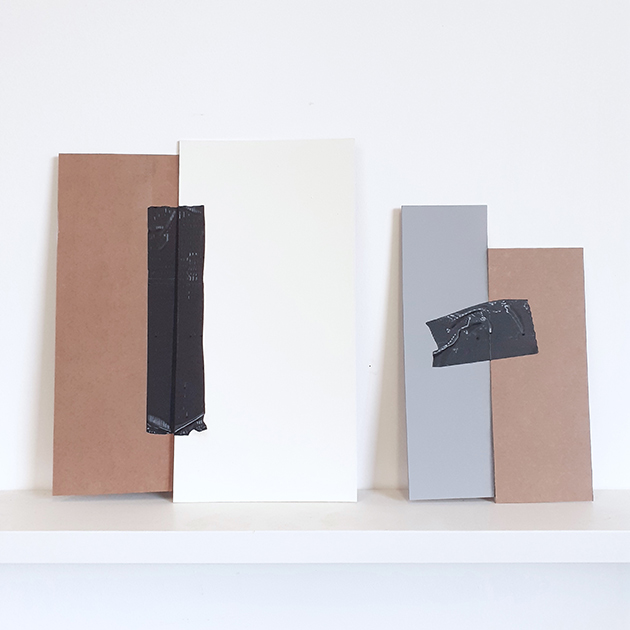
CBP: Can you talk about notions of time in the creation of your work, fast and impulsive verses slow and contemplated?
RH: The imagined artwork always appears to be more hastily created than its painstaking painted doppelganger. I’m no kind of expressionist, but I’m drawn to the possibility of a more spontaneous way of making work. [I’m not making any judgement about which might be the ‘best’ way to make art – it seems equally possible to make good or dreadful art whether you do it slowly or quickly]. I want both versions of the artwork to seem equally valid, so that the fictional version persists even after the illusion has been realised. I think something interesting happens when you take a fast creative act and slow it down, time becomes strangely elastic and it creates a space for some other thing to occur. But perhaps the work is ultimately slow and contemplative about everyday materials and their creative potentials. I’d like to think of my work as curious – in both senses of the word.
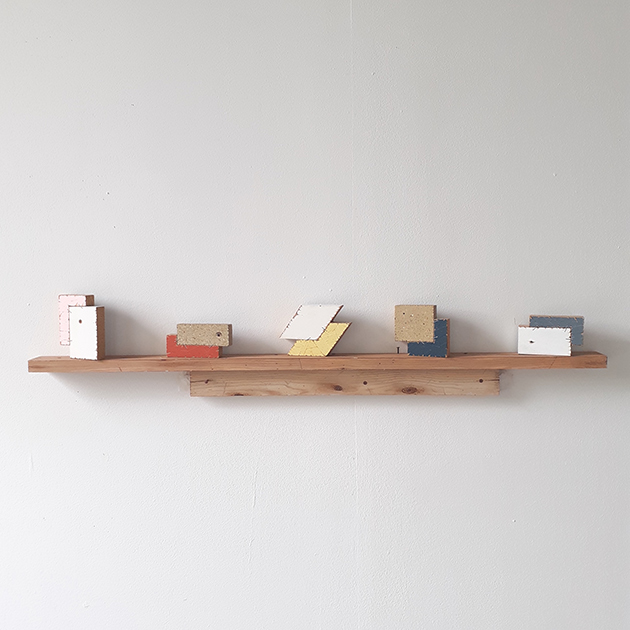
CBP: Order verses chaos, improvisation verses rehearsed?
RH: All of the above simultaneously.
CBP: Can you talk about your painting process and some of the mediums you use?
RH: Acrylic gouache paints are what I’ve used most in recent years, I’ve always liked the high pigment load and deep matt finish of gouache, the acrylic version is a slightly less seductive material to work with but much more robust. I’ll use other paints and mediums or varnishes if I want a different surface finish. I sometimes use a fair amount of drawing materials alongside the paint – graphite, and chalk pastel, along with coloured paper.
I’m unsure whether it still makes sense to describe myself as a painter these days, though I’m also not sure if that really matters. More ambiguity. Some of my work is definitely sculptural, sometimes it only appears so. There are elements of assemblage or bricolage, again sometimes real, sometimes not. I suppose I’m also an installation artist now – and there was even a hint of performance in the show at Hastings Contemporary, where the public could see some of the work being created in situ. But increasingly it all seems like a form of collage to me: whether of bits of simulated or actual materials, or of different bits of art history, genres and methodologies, ideas, words and meanings.
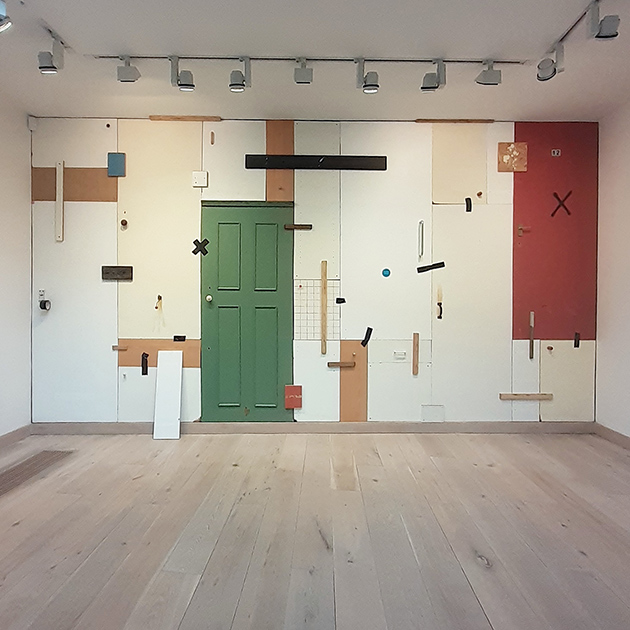
CBP: Describe a typical day or cycle in your studio.
RH: I don’t really have one right now – I’ve just relocated to the Kent coast after years and years of living in London. I’ve always had to rent workspace before, but I’m converting a large outbuilding to have my own studio down here. Will be great when it’s done, but there’s a way to go before it’ll be ready, so its a different kind of creative limbo for me right now – just making do as best I can without a proper studio till then. But it feels like a new chapter, so my normal routines are bound to be slightly different in the new space. I expect the work might change in some ways too, both because of the studio itself, and its location. Though I’m not planning to start painting seashells and fishing boats.
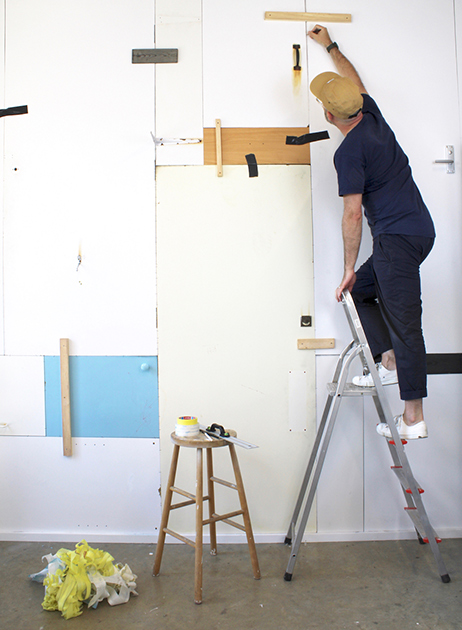
Roland Hicks, Lives and works in London.
Recent solo exhibitions include: ‘The Fourth Wall’, Hastings Contemporary,2023/24, ‘Backstreet Geometry’, 57W57 Arts, New York, 2022
Recent group exhibitions include: ‘Trinity Buoy Wharf Drawing Prize’[forthcoming, touring]2024/25, ‘Talking Things’Two person show with Lesley Bunch, Blyth Gallery, London, [forthcoming] 2024, ‘Lido Open 2024’ Lido Stores, Margate,[forthcoming] 2024, ‘Slow Painting – Surface Tension’, Plough Arts, Devon, 2024, ‘It Rose And It Fell’, Terrace Gallery, London, 2024 ‘Assembly’, Rye Creative Centre, 2024, ‘…adrift…‘, Prime Yarc, Original Projects, Gt.Yarmouth, 2024, ‘Square Dance’, Plug Gallery, Kansas City, 2023, ‘Silent Disco 23’, Greystone Industries, Suffolk, 2023.
http://www.rolandhicks.co.uk/
Instagram: @roland.hicks
